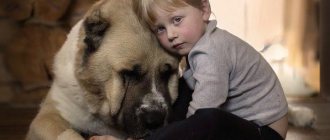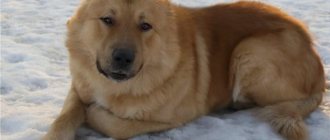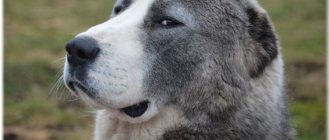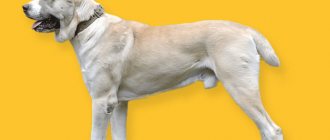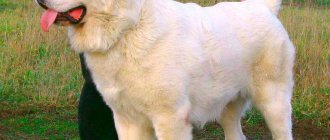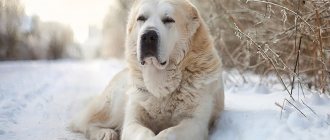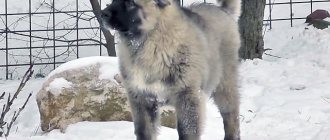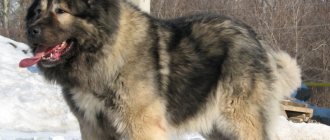Alabai is one of the strongest and most resilient dog breeds in the world.
These dogs are distinguished by their courage, bravery and viciousness towards the enemy, which makes them very dangerous in battle.
It is not surprising that many Alabai owners are interested in the question: can their pet, if necessary, defeat another large dog or even a wolf?
It would be difficult to give a definite answer to this question.
After all, in addition to height and weight, strength, courage and viciousness in such confrontations, other factors are of considerable importance.
Physical capabilities
Alabais are considered one of the oldest breeds, which for 4000 years was bred almost under conditions of natural selection and a rather harsh climate..
Even in ancient times, they were used not only to protect homes, accompany owners and, sometimes, hunt, but also to protect livestock from wild predators.
The height of these dogs, even today, exceeds 70 cm at the withers, and there are also very tall Alabais, whose dimensions can be even 1 meter at the withers, and their weight can reach 80-90 kg. By the way, today the champion in height and weight among Alabais is a dog named Bulldozer.
They have a thick, but at the same time elastic, resistant to mechanical damage skin, which can serve as good protection from the fangs of other dogs or even from wild predators.
Despite the fact that currently Alabai are more often used for guard duty than for herding and protecting livestock, these dogs still retain the qualities of real wolfhounds, such as anger towards the animal, courage and cold prudence during a duel with a predator .
At the same time, even though Alabai may outwardly look overly massive, clumsy and calm to the point of indifference, these dogs are actually distinguished by their mobility and dexterity.
They know how to evade the enemy’s teeth in battle, and then, after waiting for the right moment, pounce on him with lightning speed . And the strength and massive physique easily allows the Alabai to knock down another animal from a running start, simply by pushing it with its chest or side.
Vaccinations
The dog is given its first vaccination at the age of 2 months. After 3 weeks, the vaccine is given again. The next vaccination is given after 6 months. Further, vaccinations are given once a year. All medical procedures must be performed by qualified professionals.
Injections can only be given to a healthy dog. After vaccination, you must comply with the quarantine regime (water procedures and heavy physical activity are contraindicated). For injections, it is better to use high-quality polyvalent vaccines that meet international quality standards.
Who is stronger - Alabai or a wolf?
It is not for nothing that wolves are considered one of the most dangerous predators. They rarely wander alone, but more often stay in a flock.
Gray predators know how to find weak points in their potential victims, and their bites are characterized by the fact that wolves do not squeeze the victim with their jaws, as dogs do, but, as it were, cut it with their teeth.
Even a single bite from a wolf can be fatal. If the victim is lucky and escapes with even a relatively minor injury, then the wolves will pursue her until she becomes weak from blood loss and falls.
What will happen if an Alabai fights a wolf one on one? Here, a lot depends on where and in what conditions both animals grew up.
Alabay of the exhibition lines will most likely turn out to be a useless fighter . But even a wolf raised in captivity will not be able to adequately resist a dog, whose size and weight will be at least comparable to its own dimensions.
IMPORTANT!
What species the wolf belongs to is also of great importance for the outcome of the fight: after all, these animals, depending on the variety, can vary greatly in size, strength and viciousness.
For example, an Arabian wolf, weighing about 10 kg, will certainly be defeated by an Alabai even if the dog was not raised and trained for work.
But it will be difficult to resist a tundra or polar wolf even for the alabai, which was raised from childhood to protect livestock from predators.
Indeed, in addition to their enormous size, representatives of these species of wolves have an incredibly powerful grip: the strength of their jaws can reach up to 450 kg/sq. cm. And even not every Alabai can cope with a gray wolf common to the middle zone.
In addition, as already mentioned, wolves stay in a pack, and no one, even the strongest and most trained dog, can defeat several wild predators at once.
That is why in Central Asia, where the Alabai were originally bred, even taking into account the enormous physical strength and growth of these dogs, they were kept with flocks of livestock in packs consisting of, at most, 3-5 animals.
Pitbull
The pit bull is considered a first-class fighter and has no equal in this among other dogs of the same size . He has strong jaws and a death grip, in addition, the pit bull has no self-preservation instinct and a very low pain threshold.
It would seem that these qualities should help him in battle against larger dogs, including the Alabai. But is this really so?
As with wolves, much depends on the background of both dogs involved in the fight . An exhibition alabai, which has not been trained to resist other predators in fights, will, at best, reduce the score in such a fight to a draw.
It’s another matter if a pit bull and an Alabai of working lines, specially trained to fight wolves, come together. A dog who knows how to deal with gray predators can easily defeat a dog that weighs half as much as him.
Yes, the pit bull is more agile and nimble, but at the same time it, using the same tactics when attacking - pounce on the enemy and grab onto him with a death grip, in most cases will be defeated by the alabai.
Even if a pit bull is able to hang on the Alabai’s neck on the first try, he will only be able to grab hold of the folds of skin and the longer he clings to them, the less chance the Alabai will give him of winning.
After all, while the pit bull is just hanging out, clinging to his skin, the alabai will be able to seriously injure him.
Caucasian Shepherd Dog
Alabais and Caucasian Shepherd Dogs were bred in similar conditions and were initially used for the same work - herding and guarding sheep .
And it is not surprising that these dogs are distinguished by almost equally large sizes and similar body structure.
However, these breeds also have significant differences.
Caucasian Shepherd Dogs can be slower and heavier, while Alabais are more agile and possibly lighter in build.
The advantage of the Caucasian Shepherd is its long hair, which can also serve as additional protection from the teeth and claws of the enemy.
NOTE!
The Caucasian Shepherd and Alabai are equally bold, fearless and decisive during an attack.
However, it is also necessary to take into account that the Alabai is more inclined to act independently during a fight, while the Caucasian Shepherd Dog, to one degree or another, relies on the support or approval of the owner.
What will happen if these two dogs fight? The result of such a battle depends on many accidents and, most likely, it will hardly be possible to predict its result in advance.
In general, we can say that the Caucasian Shepherd and Alabai are almost equal in strength, endurance and fighting qualities.
Rottweiler
The Rottweiler is considered a very strong dog; it is not for nothing that one of its original purposes was to transport goods. In addition, it has strong and strong jaws.
However, Rottweilers were not bred specifically to fight wild predators and they have no malice towards other animals . Rottweiler aggression is primarily directed at people, not dogs.
However, he can be taught to fight with his own kind. But you need to take into account that while most Alabais are large and very powerful dogs, then Rottweilers can be of different sizes.
A large Rottweiler, albeit theoretically, will be able to fight on equal terms with an Alabai, but its smaller relative simply physically cannot resist the power of a real wolfhound.
German Shepherd
The German Shepherd is also a fairly large dog, but compared to the massive and tall Alabai, it clearly loses in size. However, the “Germans” are more mobile and capable of a faster attack.
Thanks to their ability to make decisions at lightning speed, German Shepherds have another important advantage over Alabai: they do not need time for long “reasoning”.
However, in a battle with a “German”, an alabai can easily knock an opponent down by simply pushing him with a running start.
If a German Shepherd and an Alabai of non-working lines meet in a duel, they may have almost equal chances of winning.
But at the same time, the “German,” even if trained, will certainly lose to the Alabai, bred for battles with predators.
After all, German Shepherds were originally bred not for fights with other dogs or wolves, but as a universal breed, the main purpose of which was to protect homes and livestock, and not so much from predators as from robbers and robbers.
Tibetan mastiff
The Tibetan Mastiff is considered a distant relative and possibly one of the ancestors of the Alabai . These dogs are distinguished by their large stature and strength. At home, in Tibet and in neighboring countries where cattle breeding is developed, they are used to protect sheep from predators.
But Tibetan mastiffs are not wolfhounds . Their purpose is to warn the shepherd about the appearance of predators, but not to enter into confrontation with them. But Tibetan mastiffs do an excellent job with other work, such as herding livestock or guarding homes.
Tibetan mastiffs are not characterized by viciousness and aggressiveness towards both people and other dogs.
The Mastiff, if given a choice, will try to avoid an open confrontation with the Alabai . At the same time, you don’t need to think that he does this out of cowardice: simply, these dogs do not like to enter into conflicts with their relatives.
They will avoid a fight until the last moment, unless they are cut off from the possibility of a tactical retreat.
If this happens, the outcome of the fight between the Alabai and the Tibetan Mastiff will be difficult to predict, since representatives of these two breeds are similar in size and physical strength.
Doberman
Most Dobermans, if they are properly raised and socialized, do not show increased aggressiveness towards other dogs, but they can stand up for themselves in the event of an attack.
The main advantages of these dogs are intelligence, intelligence, speed and agility . The Doberman is agile enough to dodge the attack of a more massive enemy, such as, for example, the Alabai.
At the same time, the Doberman can circle around its opponent for a long time, choosing the right moment, and then, unexpectedly biting him, move away again.
However, unlike equally agile and agile pit bulls, Dobermans do not tend to fight to the last drop of blood . These dogs are excellent at assessing their strength and have an inherent instinct of self-preservation.
Like other large dogs, but not originally intended for fighting predators, the Doberman will not stand a chance against the working line Alabai.
If a Doberman and a show Alabay come together in a duel, in this case the outcome of the confrontation will be unpredictable.
Alabaev mating
Female Central Asian Shepherd dogs estrus once a year (the duration of estrus is 21 days). By the time of estrus, it is advisable to decide in advance the question of the father of future puppies. It is better to entrust the choice of a male to your pet's breeder.
Both parents must have all the necessary documents (pedigrees, veterinary passports, etc.). Mating is best done 11–17 days after the bitch begins to estrus. Payment for mating is carried out according to the terms of the contract (it can be made in money or puppies).
Useful video
From the video you will learn everything about the Alabai dog breed:
Loading…
Continuing the series “Who wins”? Now let's look at who is stronger: the legendary pit bull fighter or the harsh Asian Alabay?
Let's start by comparing the brief history and external characteristics of these two breeds.
Pit bulls are dogs that were bred exclusively to fight their own kind. Later, it was from pit bulls that the decorative branch of the breed evolved, which began to be called the “American Staffordshire Terrier.” Pit bulls have not been registered by any major canine organization in the world and, in fact, do not have any clear standard.
The Pitbull is a muscular dog, very agile, with strong bones and a jaw strength of about 16-18 bar. Height varies greatly, 30-65 cm at the withers, as does weight - 15-50 kg. The Pit Bull's coat is very short and has no undercoat. Therefore, his skin is deprived of natural protection from the teeth of his opponent.
Modern “working” pit bulls are in the range of 15-25 kg, we will take the upper weight bar - 25 kg for our potential pit bull. By the way, pit bulls sometimes have their ears cropped. This is what a modern “working” pit bull looks like:
Now about the Alabaevs. Alabai - or Central Asian Shepherd Dog - is a guard dog breed. Contrary to popular belief, Alabai do not herd anyone, they are specifically engaged in protecting herds from wolves and, as a rule, work in a small pack for reliability. Taking into account this specificity of work, the breed, although large, is by no means slow. Alabais that could not cope with wolves were culled for centuries. Because no shepherd will feed a useless dog. Therefore, the selection path of the Alabai has been very tough. Alabais have their ears and tails docked immediately after birth.
The height at the withers of Alabai males (and in a potential fight we will meet males) starts from 70 cm. Weight - from 50 kg. Already at this stage it is clear that the upper limit for the height and weight of a pit bull is the lower limit for the Alabai. This, of course, gives an undeniable advantage in battle. But that is not all! The alabai has one more unconditional advantage - its wool. It has a thick coat with a thick undercoat. Its skin is also significantly thicker than that of a pit bull. The same applies to the backbone - it is much wider than the backbone of the pits. But the alabai’s main trump card is its jaw. If the average pressure of the jaw of a pita is 16-18 atmospheres, then the bite of an alabai, on average, is approximately 2 times stronger - 35-40 atmospheres.
For a potential fight, we will “take” an average working male - an Alabai weighing 70 kg.
Now let's look at the fighting style of an Alabai and a pit bull.
A pit bull (if we're talking about a real pit bull) is a dog that never stops until its enemy is dead or until the pit bull itself dies. The pit bull will not care about pain, fractures and other injuries, he will simply continue to fight. Pit bulls are very resilient and can fight for hours.
Alabai, as a rule, do not fight like that. If 2 Alabai are pitted against each other, then they fight for 15-20 minutes, then someone pins someone to the ground or someone simply runs away and then the fight ends. But this is “as a rule”. There are exceptions.
So, fight...
We agreed to consider a fight between pita weighing 25 kg and alabai weighing 70 kg. Essentially, one thing is required of the pita - not to give in to the throat. As practice shows, as soon as an alabai grabs a pita’s throat, the fight is immediately stopped. Because with its powerful jaw, an alabai can simply kill a pita in a matter of minutes. It is not enough for Pete to simply grab the Alabai by the throat, because the fur and skin will not allow him to strangle the Alabai. The only thing a pit bull can count on in a fight is to hold out for 15-20 minutes. After this, Alabai will refuse the fight and Pita will be declared the winner.
However, as statistics show, in such battles it is almost always the Alabai who win. Because all that needs to be taught to an alabai (if we are talking about a real working alabai) is to take the pita by the throat. Once this happens, the fight will either be stopped or the pit will die. The remaining few pit fights are won solely by their pressure and luck.
But if you come across a heavier pit—35 kilograms—then this greatly shifts the chance of winning in favor of the pit. But there are very few such “working” pits at the moment...
Therefore, answering the question from the title, we can say with confidence that, on average, a modern “working” Alabai is stronger than a modern “working” pit bull.
Thank you for your attention! Like and subscribe!
Also read:
Alabai is a dog that protects herds from wolves, so many are always interested in the question: which of them has a better chance of winning? Opinions are expressed that are polar opposite. For example, one half of the people are absolutely sure that an Alabai can easily defeat a wolf in a single fight. The other half believes that even the largest representative of the Alabai breed cannot defeat the gray wolf.
Nutrition
The dog is fed the following foods:
- Boiled meat (veal, chicken, turkey).
- Thick porridge (rice or buckwheat).
- Low-fat cottage cheese and fermented milk products.
- Meat broth.
- Boiled egg yolks.
- Vegetables (cabbage, carrots, zucchini).
- Sea fish (it must be deboned before serving).
- Offal (tripe, lungs, heart, liver, etc.).
The diet of the Central Asian Shepherd can include professional feed mixtures, which are enriched with special vitamin supplements. The animal needs plenty of clean drinking water.
Everyone has their own way of fighting
Wolf vs Alabai - who will win the fight
In a duel, everyone acts differently
Since the principle of the alabai is to crush the opponent, then in order to obtain a winning position, he needs to make sure that the wolf is under him. And then the dog can already grab the enemy’s throat. But even at such a moment, the alabai will not be able to inflict deep wounds on the wolf, this is how its oral cavity is structured. But the goal of this dog is not to bite its opponent to pieces - the Alabai is excellent at strangling. And this method of fighting just gives him the opportunity to do this for as long as possible, so that the enemy can no longer resist. A distinctive feature of the alabai is the ability not to loosen its grip, even if it has already received many wounds.
Wolf vs Alabai - who will win the fight
The wolf acts completely differently. It tries to inflict the most damage by sinking its teeth into the enemy. This is a more resilient animal than a dog, and besides, it knows where the victim’s weak points are. Most often, wolves move and hunt in packs, although there are also loners who turn out to be much larger than their “pack” relatives - after all, they get food only for themselves and do not need to share with anyone.
Photos
Next Previous
Charming hostess of Alabai
A happy family!
Nice smile!
Trusted friend
Next Previous
The main factor of victory
Wolf vs Alabai - who will win the fight
You can try to “calculate” the winner
In dogs, an extremely important circumstance that will influence its behavior in the future is the environment in which it was raised. Dogs raised on the street and those raised at home will behave completely differently. A domesticated Alabai who has no idea about fighting will become an easy prey for a gray wolf. But the wolf is unlikely to be able to cope with a dog who has always had only one goal in his life - to protect or guard something at any cost.
Wolf vs Alabai - who will win the fight
But, again, even if an Alabai experienced in battle is alone, and there is a pack of wolves against him, it is not a fact that he will survive. The bite force, on average, between a dog of this breed and a wolf is also very different - if in an Alabai it is only 150 kg/cm², then a wolf bites with a force of 450 kg/cm². In addition, the wolf has more powerful jaws and a sense of smell 10 times stronger than a dog's.
Is dog fighting barbaric, is it necessary to check the wolfhound, or is it a business?
Animal advocates unanimously argue that dog fighting is barbaric. Like, why find out who is stronger if it can lead to the death of the dog? These people are partly right, because dog fights very rarely result in casualties. And especially if such massive and dangerous wolfhounds are involved in the battles. We must not forget that some dogs were bred specifically for this purpose, right?
But if you look at it from the other side, dog owners themselves can decide for what purpose to raise their pet. Of course, fighting is an integral part of the life of any born fighter. After all, if a pet does not show its strength with other animals, then it can do this even involuntarily just on the street. But then the outcome will be sadder.
Sorry, there are no surveys available at this time.
Today, dog fighting is prohibited in many countries. Today the practice of holding such events is not as widespread as in the last century. Then such a business could bring fortunes to the organizers. Nowadays, of course, such competitions also bring income to the organizers, professional videos are filmed, and there are even fans of this type of “sport.”
Pros and cons of the breed
The undoubted advantages of the breed are:
- Developed protective instincts and menacing appearance.
- Good health.
- High level of intelligence and good memory.
- Unpretentiousness.
Obvious disadvantages of alabai :
- Willful and independent character.
- Doesn't get along well with pets.
- May show unmotivated aggression towards passers-by and other dogs.
- Maintaining alabai requires significant financial investments.
- The dog is of impressive size and takes up a lot of space in the apartment.
Raising a reliable protector
To achieve success in wrestling, the dog must undergo special training starting from the age of two months. If it is not possible to conduct it with specialists, the Internet will help, with videos presented on the rules of training.
When raising an Alabai, it should be taken into account that this is a thinking breed. The dog will not carry out a command whose expediency is unclear to him. It is necessary to look at the pet’s reaction when setting feasible tasks.
Training requires enormous patience, perseverance and mental flexibility. Trying to force your way leads to failure and loss of trust.
Correctly selected behavioral tactics during training will help raise a serious and intelligent pet, capable of protecting against any danger, including a wolf.
Nicknames for Alabais
Alabai is a large dog with a fighting character. The nicknames of Central Asian Shepherds should reflect the psychology of the animal and emphasize its advantages.
Nicknames for male dogs: Hammer, Bear, Atlas, Antey, Hercules, Ram, Boar, Mars, Whirlwind, Executioner, Watch, Athlete, Abrek, Khan, Shah, Bai, Buran, Hurricane, Diamond, Assault, Guardian, Vulcan, Leader, Mamai, Udar, Sherkhan, Shaman, Uranus, General, Trap, Blade.
Nicknames for bitches: Armor, Zarya, Dream, Blizzard, Thunderstorm, Rose, Storm, Cannon, Dream, Gerda, Myna, Mira, Puma, Panther, Attack, Hera, Fury, Wall, Mine, Bomb, Arch, Gyurza, Palmyra, Mamba, Dora, Queen, Mile, Tower, Heat, Race, Victory, Strength, Fairy Tale.
Jaw strength
Wolves have a strong jaw, sharp teeth, which are built in a special way. When attacked, the wolf's bite force reaches 450 kg/sq. cm. For comparison: the bite force of a white shark is 600 kg/sq. cm. In dogs, this figure is no more than 130 kg/sq. cm. Even bears have a lower bite force than wolves - 200–250 kg/sq. see. Based only on these indicators, it is clear who is stronger - a wolf or a dog.
Choosing a puppy and prices
You can purchase Central Asian Shepherd Dog (CAO) puppies only from specialized nurseries that have an FCI/RKF certificate. At the time of purchase, the little Alabai must be 2 months old. The breeder is required to provide a certificate of origin and a veterinary passport. It is also worth paying attention to the presence of a mark and a special chip that is implanted under the skin of the animal.
If possible, try to get to know the puppy's parents. You should be satisfied with their character and appearance. Observe how the Alabai puppy behaves in a group. He should actively play with other dogs and strive to take a leadership position.
Examine your puppy's teeth; he should have a scissor bite. The animal's fur should be dense, soft and shiny. The dog should not be afraid of sharp sounds and sudden touches. He must have a good appetite, clean eyes and ears. The cost of a SAO puppy ranges from 15 to 25 thousand rubles.
Bad habits of Alabai
Central Asian Shepherd Dogs can bark and howl at night . This feature of the animal causes a lot of concern for the owner and neighbors in the house. Central Asian Shepherd puppies periodically chew shoes and clothes. Sometimes it gets to the feet of the owners. The dog needs to buy special toys so that it can exercise its jaws.
Alabais, which the owners keep in their summer cottages, can do “earth work.” They will begin to spoil the beds and trample the flower beds. The owner must protect the plants with a strong net or make a fence.
As a sign of protest against the owner’s orders, the animal may relieve itself in the wrong place. Such behavior should be stopped with a condemning tone. Most of the problems associated with keeping Alabais can be solved through proper education and training.

